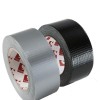What duct tape is for. Here is a list of its main uses
What can duct tape be used for? The right question should be, rather: what can’t duct tape be used for?
This tape, also called American tape and duck tape – we’ll explain why in a bit – should not be missing in any toolbox, and should actually be present in any emergency bag as well.
Inside the workshop, on construction sites, in the shop, in the car or in the boat, American tape can always be very useful. To understand that the duct tape can have a thousand uses it isn’t necessary to be a MacGyver fan who – with just some duct tape and a Swiss army knife – could do anything: so let’s have a look at what duct can be used for!
What is duct tape
There is always something that breaks and needs quick and emergency repair: In many cases, the tape can solve the situation with a makeshift repair job – not to mention the occasions in which duct tape becomes a permanent and absolutely stable repair solution.
But what is duct tape? Well, it comes in many different types. In principle, however, the name describes all double-sided tapes that have an inner cloth webbing, thus a cloth surface which presents an adhesive side.
usually, duct tape is made waterproof by an additional layer of polyethylene.
The history of cloth tape, also known as duck tape
As we have already established elsewhere in this blog dedicated to professional adhesive tape, double-sided adhesive tape was discovered and developed in the twenties, stemming from the intuition of an employee of the company 3M.
We can consider duct tape as one of the evolutions – one of the best ones – of that first product. The development of the first industrial double-sided cloth adhesive happened in the middle of World War II.
Apparently, the idea came to a worker, Vesta Stoudt, who mentally combined the properties of strong double-sided tape and the duck tape, that is, strips of thick non-adhesive cloth that, at the time, were used as reinforcement to wrap cables, to reinforce clothing, shoes, and so on.
The woman didn’t just think about this possible product, she did more than that, in fact writing a letter to none other than President Franklin Delano Roosevelt, in 1943: in this letter Vesta, who had two sons enlisted in the U.S. Navy, explained that, with an adhesive tape of this type, it would be possible to seal ammunition crates easily and quickly, offering good advantages in combat.
The message was directed to the War Production Board, which handed over the development to Johnson & Johnson which, through one of its divisions, had been producing adhesive strips of medical duck cloth for years.
In a short time frame, the new industrial double-sided cloth adhesive tape was developed, fast to cut, to apply and to remove, resistant even in difficult conditions. It was made of a layer of cotton duck canvas, a rubberized adhesive layer, and an upper polyethylene layer.
From the beginning it was also used for makeshift repairs on military vehicles and weapons.
At the end of the conflict the production rights were then bought by a building materials manufacturer, to give way to the widespread adoption of duct tape.
The Uses of American Tape: What can duct tape be used for?
As it has been outlined, duct tape was used to carry out repairs in difficult situations from the outset.
To this day, duct tape is used in the military, with different types of tape: a particular type of cloth tape, for example, was used during the Vietnam War to balance the blades of helicopters, thanks to its great resistance ability.
It was then stated that, ever since the Gemini program, all NASA missions have brought duct tape on board to be used in emergency situations: For example, some duct tape was used on the Apollo 13 to adapt the carbon dioxide filters of the command module to the lunar one; and again, on the Apollo 17 mission, duct tape was used to repair a fender of the lunar rover.
Duct tape is currently used for emergency repairs to pipes and ventilation ducts, or even for emergency repairs to boats such as dinghies and kayaks in case of punctures or damage to the hull.
There is no hope of counting all the alternative and imaginative uses that the cloth tape has known over the years: online, you’ll be able to find stories of people who used duct tape to create emergency rope, to cover blisters on their feet during hiking, to splint broken limbs, to patch up clothes and shoes, or even to mark a path, as well as to create wallets and purses.







